Please take a few minutes to watch the short but exciting video, and then consider becoming a backer and share with your friends and family.
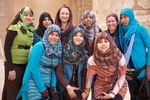 Teen girls at Karnak Temple spent 15 minutes talking with ConserVentures directors Roseann Hanson and Diane Boyer on a recent trip to Egypt.If some of our friends and family thought we were foolish for regularly traveling to Mexico, the reaction when we announced we were going to Egypt was incredulity. “Where? Are you nuts?”
Teen girls at Karnak Temple spent 15 minutes talking with ConserVentures directors Roseann Hanson and Diane Boyer on a recent trip to Egypt.If some of our friends and family thought we were foolish for regularly traveling to Mexico, the reaction when we announced we were going to Egypt was incredulity. “Where? Are you nuts?”
It didn’t help that, shortly after we left Cairo to explore the Western Desert, several Americans were detained by the army (to breathless headlines in the U.S.), and two women tourists and their guide were kidnapped in Sinai by fractious Bedouin nomads.
It developed that the detained individuals, who worked for a couple of NGOs, were allegedly misusing funds to engage in political activities, a big no-no for a tax-exempt organization, and the tourists, who were released within hours, commented on the generous hospitality shown by their kidnappers, and retained no animosity at all. Nevertheless, fears for our safety spiked.
Meanwhile, blissfully ignorant of all this, in every oasis and neighborhood we visited we were continually accosted by people who asked where we were from, and on being told “America,” grabbed us, shook our hands, and said, “Thank you so much for coming!” Some were near tears. Everywhere people shouted, “America number one!” and, “Obama!” with big thumbs-up. We lost count of the demands to have our photos taken with residents; there’s no telling how on many Facebook pages we now co-star.
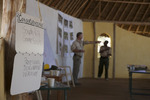 Despite a language and culture gap many would consider formidable, two law enforcement rangers from the U.S. Park Service bonded instantly with a group of 28 Maasai game scouts from the South Rift in Kenya.
Despite a language and culture gap many would consider formidable, two law enforcement rangers from the U.S. Park Service bonded instantly with a group of 28 Maasai game scouts from the South Rift in Kenya.
During an intensive, ConserVentures-sponsored three-day workshop held at the Lale’enok Resource Center, about 90 miles south of Nairobi, Gary Haynes and Michael Hardin shared their training and experience in tactics for tracking poachers who might be armed and capable of laying an ambush to surprise their pursuers. In return, Gary and Michael were embraced as brethren by the Maasai rangers, who quickly recognized and valued their shared professionalism and similar challenges, and who gave as good as they received in explaining fieldcraft relevant to the African bush. Michael Lenaimado, head of the scouts and fluent in Maa and English, translated throughout the training, but after the first day or two much of the one-on-one interaction seemed to take place more by telepathy than talking.
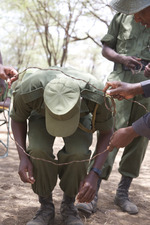 Scouts demonstrating a poacher's snare.The Maasai game scouts in Kenya’s South Rift Valley will soon have extra skills—and some extra equipment—in their arsenal, to help them to continue protecting the rich wildlife of the Shompole and Olkirimatian communities.
Scouts demonstrating a poacher's snare.The Maasai game scouts in Kenya’s South Rift Valley will soon have extra skills—and some extra equipment—in their arsenal, to help them to continue protecting the rich wildlife of the Shompole and Olkirimatian communities.
ConserVentures has hired Gary Haynes, a retired law enforcement officer with the U.S. Park Service, to lead a seminar in early October to lead a professional development seminar in early October to teach 35 scouts additional skills in tactical anti-poaching tracking. Gary was trained in man-tracking techniques by such specialists as David Scott Donelan, a veteran of the bush wars in southern Africa in the 1970s and 1980s. Assisting Gary will be Michael Hardin, a currently serving law enforcement officer with the Park Service who has extensive experience tracking and pursuing smugglers and fugitives throughout the western U.S., and ConserVentures volunteers Mike McCarthy of Park City and Bill Meilhan of Texas.
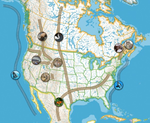 Image from SummitCountyVoice.comJust as humans need roads and highways to move between home and work, animals, especially large mammals, need protected corridors for migration, breeding, and finding food and water. These Wildlife Movement Corridors have become a vital tool for ensuring the survival of many species.
Image from SummitCountyVoice.comJust as humans need roads and highways to move between home and work, animals, especially large mammals, need protected corridors for migration, breeding, and finding food and water. These Wildlife Movement Corridors have become a vital tool for ensuring the survival of many species.
For decades, the standard approach to wildlife conservation around the world was to set aside large blocks of land that were then safeguarded from development and over-hunting. While these areas—from Yellowstone in the U.S. to the Serengeti in Africa—are vital as core habitat for thousands of species, biologists slowly realized they could not exist in isolation. In the U.S., for example, we learned that such animals as mountain lions, bighorn sheep, black and grizzly bears, elk, and many other large herbivores and carnivores regularly move between mountain ranges and other designated protected landscapes. This movement prevents inbreeding, allows escape from drought or fire-stressed environments, and lets animals follow seasonal changes in grazing or hunting. However, these corridors often cross unprotected land that is developed or in danger of being developed. By identifying where animals move, potential conflict can be mitigated or eliminated altogether.
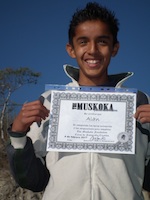 The Muskoka Foundation, whose tagline is “Use What You Know to Do Good as You Go,” is getting the summer off to a great start with programs for travelers throughout Canada, USA, Latin America and Africa. Many overlanders don’t realize how much of a difference they can make in their own backyards: Muskoka has volunteering locations in Inuvik, along the Top of the World Highway; in Seward, along the spectacular Kenai Peninsula; and down to Canyon de Chelley in Arizona, to name a few.
The Muskoka Foundation, whose tagline is “Use What You Know to Do Good as You Go,” is getting the summer off to a great start with programs for travelers throughout Canada, USA, Latin America and Africa. Many overlanders don’t realize how much of a difference they can make in their own backyards: Muskoka has volunteering locations in Inuvik, along the Top of the World Highway; in Seward, along the spectacular Kenai Peninsula; and down to Canyon de Chelley in Arizona, to name a few.
Muskoka runs programs for youth in photography, entrepreneurship, IT, and business, as well as “no volunteering skills required” programs in music and artisan crafts. The foundation provides all the equipment, contacts, and curriculum to get volunteers started, all you need to do is show up. TheMuskokaFoundation.org, or Twitter @dogoodasyougo
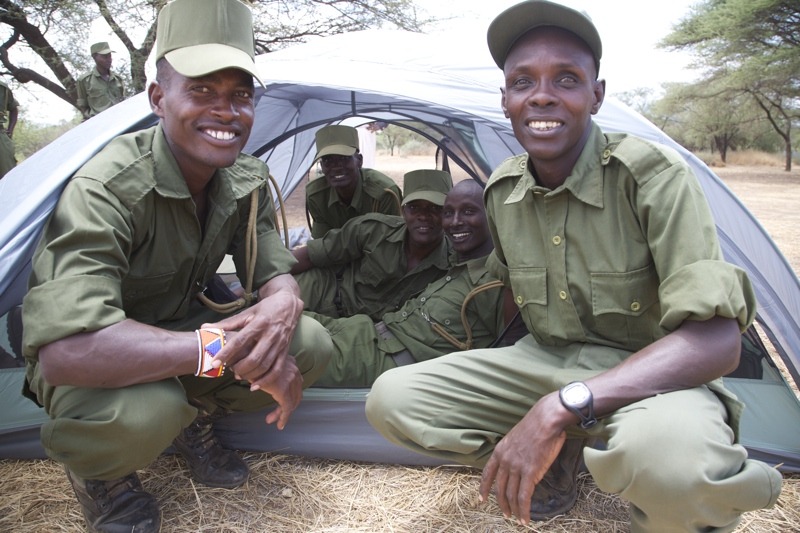
Tracking poachers through the African bush is a bit different than following a set of hoofprints in the hope of spotting a kudu for a photo safari. To start with, kudus don’t carry AK47s. Nor are they likely to double back and set up a point ambush.
Whether you’re after man or beast, tracking is an intensely focused activity. Signs are usually faint and ambiguous—a partial print here, a scuff there. It’s like trying to assemble a jigsaw puzzle with half the pieces missing. A good tracker looks ahead frequently to infer in which direction his quarry is likely to have gone, but 90% of the time his attention is directed just a few feet ahead.
And that can be hazardous if the quarry is a band of armed poachers. To improve game ranger success and personal safety, ConserVentures is working with the South Rift Game Scouts in Kenya to pay for and host a tactical tracking seminar in Kenya this October, as part of our Resources for Rangers program. Our team includes professional law enforcement officers for five days of intensive instruction.
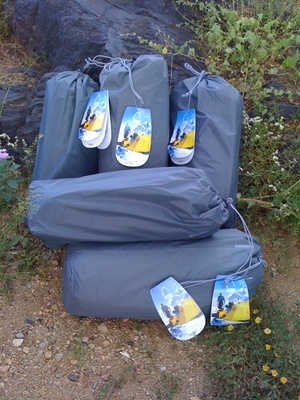 Sierra Designs tents has donated five Lightning XT 2- and 3-person tents for the wildlife rangers of the South Rift Game Scouts Association. Also on the way, due to the generosity of several other donors, are five Garmin GPSs and five waterproof Bushnell binoculars. We will be taking them to Kenya next week. This equipment will help the new scouts association in their mission to combat poaching of wildlife, and to continue their fieldwork gathering data and ensuring the safety of community members and tourists in the South Rift. Find out more about Resources for Rangers . . .
Sierra Designs tents has donated five Lightning XT 2- and 3-person tents for the wildlife rangers of the South Rift Game Scouts Association. Also on the way, due to the generosity of several other donors, are five Garmin GPSs and five waterproof Bushnell binoculars. We will be taking them to Kenya next week. This equipment will help the new scouts association in their mission to combat poaching of wildlife, and to continue their fieldwork gathering data and ensuring the safety of community members and tourists in the South Rift. Find out more about Resources for Rangers . . .